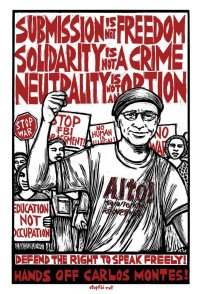 The following article by Debdutta Ghosh, Mou Chakravarty and Drimi Chaudhuri is from the Hindustan Times:
The following article by Debdutta Ghosh, Mou Chakravarty and Drimi Chaudhuri is from the Hindustan Times:
Charu Majumdar is dead for about 40 years. Kanu Sanyal is 78, ill and infirm, staying at his native village in north Bengal. Asim Chatterjee has mellowed. But Naxals — in their new avatar — are coming back to Kolkata.
On June 28, 1967, Radio Peking (in China) called it ‘The Spring Thunder’. The occasion was the May 1967 rebellion in north Bengal’s Naxalbari by a small breakaway faction of the Communist Party of India (Marxist).
Later, on April 22, 1969 — Russian revolution leader V.I. Lenin’s birthday — the rebels formed the Communist Party of India (Marxist-Leninist). But the announcement was made earlier at a public rally in Calcutta (the old name of Kolkata) by Kanu Sanyal on May 1 that year. The thunder fizzled out by 1972.
After spending about 35 years in the wilderness, the Marxist-Leninists morphed into the Communist Party of India (Maoist) in 2005 — after dividing and reuniting several differing factions operating almost independently.
And from the wilderness of Chhattisgarh, Jharkhand, Bihar, Orissa and West Bengal, they are planning to lay a siege to the cities, especially Kolkata.
How? In a classic Maoist strategy coming out of the pages of the Red Book — “Surround the cities with villages” — the Maoists have started their march towards Kolkata.
This time, with a strong presence in three West Bengal districts — West Midnapore, Purulia and Bankura, all within 200 km from Kolkata — they are trying to close in on Kolkata’s neighbouring districts of North and South 24 Parganas.
How is the ruling Communist Party of India (Marxist) responding to Maoist plans?
All that Rabin Deb, member of the CPI(M) state secretariat, had to say was: “The Maoists have spread tentacles in the city (Kolkata). There is an unholy nexus among the rightists, the ultra-Left and the media.”
The come-back trail
When 28-year-old Dipanjan Chatterjee, a resident of Muraripukur in north Kolkata — a hot bed of Naxal violence in the seventies — was given a five-year sentence for his role in the October 2003 murder of Nilmadhab Das, officer-in-charge of Bandowan police station in Purulia, people thought it was a one-off incident.
But things began to look different when in October 2009, Swapan Dasgupta, editor of the Maoist mouthpiece, People’s March, was arrested from the College Street area of north Kolkata, which is still remembered as then student leader Asim Chatterjee’s favourite battleground.
Dasgupta’s arrest for the first time jolted the ‘Whatever happens in districts are remote, Kolkata is safe’ syndrome.
Things became clearer when on March 2 evening, the Maoists’ state committee member and Bengal military commission chief, 44-year-old Venkateswar Reddy, alias Telugu Deepak, was nabbed by the state police at a bus stand in Behala on the southern fringes of Kolkata — another Naxal terror-hit area of the seventies.
On February 26, 2009, Maoist ideologue and author Varavara Rao held a press conference in the Jadavpur University (JU) campus — strangely, with the authorities having been unaware of the event.
“Our support is growing among the students of Kolkata,” he declared. “Though these students do not come from the tribal areas, I feel they understand the situation in the Maoist belts.”
Power of sympathy
Raj Kanojia, additional director general, Criminal Investigation Department (CID), said: “Telugu Deepak had been staying in Kolkata for some time. He had been deputed to the city to build a network, and work with sympathisers.”
While interrogating Deepak, sleuths have been focusing on the Maoists’ network of sympathisers in the city.
Just as in the seventies, students are taking the lead. Maoist posters are popping up in colleges and middle – and lower-middle-class residential areas such as Muraripukur in north Kolkata; Behala, Jadavpur and Garia in the south; and even upper-middle-class Salt Lake.
Public face
The Maoists have set up several frontal organisations in the city. One of them is Matangini Mahila Samity, a women’s outfit. “I now work for Matangini Mahila Samity. We (the Samity) worked in Nandigram and Lalgarh too,” admitted Konika Debnath, resident of Girish Park in north Kolkata and an accused in the 2003 Nilmadhab Das murder case.
The police also allege that organisations like the Bandimukti Committee and Lalgarh Mancha are in the same league. Members of such organisations never admit to their Maoist links, but they strongly voice their support for democratic movements.
The Bandimukti Committee’s Chhoton Das said: “We are not Maoist sympathisers, but we demand immediate release of political prisoners, including those branded as Maoists.”
Asim Chatterjee remembers: “We found sympathy and support from poor middle-class neighbourhoods such as Behala, Taltala, College Street and Baranagar. But we failed to propagate our ideas among the poor workers.”
This time, however, workers are very much on the Maoist radar. Among the tasks entrusted to Deepak was to create a base among the poor industrial workers in and around Kolkata.
The Maoists seem to have prepared the ground for another onslaught on Kolkata, but the city’s defenders are oblivious to the weather reports about the next thunder.
















